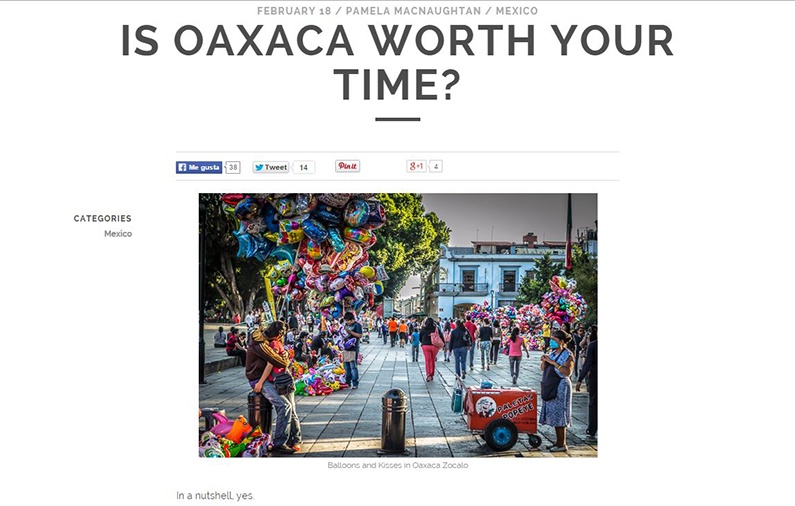Is Oaxaca Worth Your Time?

I admit, I was a little leery of travelling to Oaxaca last year. Usually places that garner so much positive press are overrun with travellers and I get a little suspicious. I want to explore Mexico, not float from tourist hotspot to tourist hotspot! It sounds absolutely ridiculous, I know. I think it’s because I like to make up my own mind about a place and therefore I tend to not listen to (or read about) other’s opinions before I arrive. I mean what if I go all hyped up and it blows? That is no fun.
When I arrived in Oaxaca last year after a very bumpy bus ride that had me curled up on the floor with motion sickness, I was very blasé – until the following day when I started exploring, that is when I started to fall for the colonial city of Oaxaca. Sure there are hawkers at the market pushing their wares and trying to make a living, but unlike Chiang Mai, Thailand, they don’t follow you all the way into the bathroom in an attempt to make you buy a wooden frog.
Oaxaca was peaceful, brimming with culture, and a foodie haven. I ended up spending a week in Oaxaca, and although I was exhausted by that point (I had already been travelling by bus through the interior for about 3 weeks), but I left loving it.
Oaxaca state is home to over 400 municipalities (many of which are governed based on customs and traditions), at least 16 different indigenous languages and cultures, and the location of Monte Albán – one of the more interesting ruins in my opinion.
As one of the more culturally diverse states in Mexico, a visit to Oaxaca gives travellers an opportunity to interact with and learn about a variety of indigenous cultures and traditions. Something that can be done by attending cultural festivals, hiring a guide to take you into smaller communities, visiting locals markets, or exploring the ancient ruins of Monte Albán.
Ancient Zapotec ruins located just 10 kms (or so) from Oaxaca City, Monte Albán sits about 6,400 ft above sea level, dates back to around 500 BC, and offers sweeping views of the Oaxaca Valley below. My visit to the ruins was definitely a highlight (thanks to my guide Suzanne) as I learned a little more about the Zapotec culture, and frankly, the ruins were far more interesting than many of the ruins I’ve visited in Mexico.
Many of the ruins I’ve visited are one level, meaning you walk around from pyramid to pyramid and after about 30 minutes I am ready to go. Monte Albán is different in that there are at least three levels of ruins, making exploration even more fascinating (in my opinion).
Tip: paying for a guide is definitely worth it when visiting these ruins as they are complex and absolutely fascinating.
My focus for Oaxaca this year was food because food + Oaxaca = awesomesauce!
On of my favourite things to do while travelling is to take a local cooking class. It’s a great way to learn about local cultures and traditions, and I am always excited to add a new dish to my recipe book. I am a foodie after all.
There are a few cooking class options in Oaxaca. I’ve taken two. The first one was a tamale class taught by a local woman named Clara. The class is held at Hotel Azucenas and one of the better tamale experiences in Mexico (I say this as I don’t like tamales and I actually ate and enjoyed a whole one after my cooking class). Can you say Mole Tamales?! Definitely worth trying out. Note: Clara speaks very little English, but she is utterly delightful.
Chef Jorge Valdéz offers a cooking class through Hotel Los Laureles which features a guided visit to one of the markets in Oaxaca and then a more upscale cooking menu which is prepared in the garden back at the hotel. One of my favourite things about this cooking class is having access to a local chef who has been working in Oaxaca for 10 years and has extensive knowledge about the food, culture, traditions, etc. This is a great way to learn more about the region and can be booked through the hotel.
Oaxaca is brimming with markets, both food and souvenir/clothing. Many of the markets are located around the zocalo (centro historico) and are a must on every itinerary. Markets are one of the best places to experience local culture, learn about regional dishes, and of course, people-watch.
The best time to visit the markets is in the morning when the market is busy with locals rather than tourists (who tend to start arriving late morning, early afternoon). A market visit in Oaxaca should always include sampling fresh Oaxaca cheese, smelling mole paste (maybe I’m the only person who does that), buy some fresh herbs for tea, and possibly try some spicy grasshoppers – unless you’re like me and cannot convince your gag reflex to relax.
As such a culturally diverse state, Oaxaca is overflowing with artisans and visitors can find everything from contemporary to tradition art within the city and surrounding areas. One of the more popular art forms is black pottery, which can be found in many shops throughout the city. While shopping in a boutique is quite easy, think about hiring a guide and venturing out to San Bartolo, a community best known for making black pottery (they’ve been making it for 2,000 years).
This is what I love about Oaxaca, each community has its own speciality that they have been doing for hundreds of years. Black pottery. Green pottery. Basket weaving. You could visit Oaxaca just for the art and artisans and have a very full schedule.

